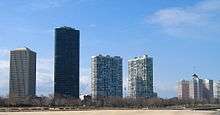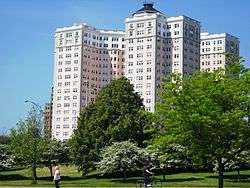Edgewater Beach Hotel
| Edgewater Beach Hotel | |
|---|---|
 Postcard of Edgwater Beach Hotel circa 1916 before the addition of the south tower. | |
| General information | |
| Architectural style | Spanish Colonial Revival[1] |
| Location | 5301-5355 N Sheridan Road Chicago, Illinois |
| Country | United States |
| Coordinates | 41°59′1″N 87°39′17″W / 41.98361°N 87.65472°W |
| Construction started | 1916 |
| Completed | 1924 |
| Demolished | 1970 |
| Cost | US $9,000,000[2] |
| Client | John Tobin Connery and James Patrick Connery |
| Design and construction | |
| Architect | Marshall and Fox[1] |
|
Edgewater Beach Apartments | |
|
The Edgewater Beach Apartments, built in 1927, sole portion of complex now standing | |
   | |
| Location | 5555 North Sheridan Road, Chicago, Illinois |
|---|---|
| Coordinates | 41°59′1″N 87°39′17″W / 41.98361°N 87.65472°WCoordinates: 41°59′1″N 87°39′17″W / 41.98361°N 87.65472°W |
| Built | 1928 (co-op apartments) |
| Architect | Marshall and Fox |
| Architectural style | Beaux-arts / Historism[3] |
| MPS | Bryn Mawr Avenue Historic District |
| NRHP Reference # | 94000979 [4] |
| Added to NRHP | August 16, 1994 |
The Edgewater Beach Hotel was a resort hotel complex on Lake Michigan in the far-north neighborhood community of Edgewater in Chicago, Illinois, designed by Benjamin H. Marshall[5] and Charles E. Fox. The first section was built in 1916 for its owners John Tobin Connery and James Patrick Connery, located between Sheridan Road and Lake Michigan at Berwyn Avenue. An adjacent south tower building was added in 1924.[6] The resort hosted famous movie and sports stars, and later Martin Luther King, Jr. It was also the setting for the celebrity stalking case and shooting, which inspired the book and a movie, The Natural. The hotel closed in 1967, and was soon after demolished.
The Edgewater Beach Apartments to the north were completed as part of the hotel resort complex in 1928. The "sunset pink" apartments complemented the "sunrise yellow" hotel in a similar architectural style.[7] The apartments remain standing and have been listed on the National Register of Historic Places.
Design
Designed by Chicago-based architects Marshall and Fox, the complex was composed of several buildings and recreation grounds. The Main Building, designed in the shape of a croix fourchée ("forked cross"), had 400 rooms and opened on June 3, 1916. It quickly became a success. In April 1923, construction began on a $3,000,000 19 story, 600-room tower addition to the south of the Main Building.[8] The Tower Building, which opened for occupancy on February 9, 1924, had a stepped design, tallest at its center, with lower sections to the east and west of the center. The addition, initially called the Annex, was connected to the Main Building by a large hall known as Passaggio.[9]
The hotel had a 1,200-foot private beach and offered seaplane service to downtown Chicago.[1][10] When both buildings were initially constructed, the hotel sat 20 feet from Lake Michigan.[11] The 1933 extension of Lake Shore Drive north to Foster Avenue resulted in the creation of a private bathing beach east of the hotel and north of Foster along the Lake Michigan shore.[10][12]
History
During its lifetime, the hotel served many famous guests including Marilyn Monroe, Frank Sinatra, Judy Garland, Charlie Chaplin, Bette Davis, Lena Horne, Tallulah Bankhead, and Nat King Cole, and U.S. Presidents Franklin D. Roosevelt and Dwight D. Eisenhower. The hotel was known for hosting big bands such as those of Benny Goodman, Tommy Dorsey, Glenn Miller, Artie Shaw, Xavier Cugat, and Wayne King, which were also broadcast on the hotel's own radio station, a precursor to WGN with the call letters WEBH. In the winter months the bands played in the Marine Dining Room and, in the summer months, outdoors on the marble-tiled Beach Walk. On the first floor of the hotel, guests walked on a wooden gangway into the Yacht Club for cocktails. In the early days women were not permitted to sit at the bar.[13]
On June 14, 1949, Philadelphia Phillies first baseman Eddie Waitkus was shot and nearly killed by an obsessive fan at the hotel, 19-year-old Ruth Steinhagen; this later would be a large part of the inspiration behind Bernard Malamud's novel The Natural.[14][15]
The 1951–54 extension of Lake Shore Drive from Foster Avenue to Hollywood Avenue cut the hotel off from direct access to Lake Michigan, leading to a reduction in business. This roadway was built on landfill in the area that had been the beach for the hotel. After the hotel was cut off from the lake by the new drive, a swimming pool was added in 1953. In 1960, in order to compete with popular downtown hotels, the Edgewater Beach underwent a $900,000 renovation which included the installation of air conditioning. Approximately 30% of rooms, including restaurants and public spaces of the hotel, were fitted with air conditioning. By 1961, that number rose to nearly 70%.[16]
From January 14–17, 1963, the National Conference on Religion and Race was held at the resort. Martin Luther King, Jr., assisted by Wyatt Tee Walker, was on the steering committee for the conference, which was called by the National Council of Churches, Synagogue Council of America, and the National Catholic Welfare Conference. King gave a major address at the conference, "A Challenge to Justice and Love", to commemorate the 100th anniversary of the Emancipation Proclamation. He called the conference, ‘‘the most significant and historic ever held for attacking racial injustice.’’ A statement in support of civil rights from President John F. Kennedy was read and Abraham J. Heschel also spoke. The conference adopted An Appeal to the Conscience of the American People for a moral end to racism.[17]
Closure and Demolition
The hotel closed abruptly on December 21, 1967 following bankruptcy proceedings. The building was leased to Loyola University in the fall of 1968 for use as a dormitory to house 300 students. By January 31, 1969, the Loyola students residing at the Edgewater Beach relocated to new housing constructed on the University's campus.[18][19] Demolition of the hotel complex began in the fall of 1969 and was completed by 1971.
Edgewater Gulf Hotel
The developers also built a sister hotel, the Edgewater Gulf Hotel, in Biloxi, Mississippi, which closed in 1970. Both projects were designed by the Chicago architectural firm of Marshall and Fox.
Apartments
The Edgewater Beach Co-op Apartments, built in 1928 at the north end of the property,[3] and shown in the photo at right, is the only part of the hotel complex to survive and is part of the Bryn Mawr Historic District. As he had before with many his other projects, such as the South Shore Country Club, the Blackstone Hotel, the Drake Hotel and Drake Tower, architect Benjamin Marshall designed the apartment building with accoutrements suited for the well-to-do.[20] It was added to the National Register of Historic Places in 1994. The apartments stand at the north end of Lake Shore Drive, quite visible to the passing traffic, and unusual in Chicago for the "sunset pink" exterior. When both buildings stood, the color coordinated with the "sunrise yellow" of the hotel.[7]
The retail portion of the current building contains the Anna Held Floral Shop and a restaurant.
Photo gallery
-

Then: the Edgewater Beach Hotel viewed from the north in 1923
-

Now: photograph from a similar position in 2006
-

Site of the Edgewater Beach Hotel complex viewed from the southeast in 2006
References
- 1 2 3 "Edgewater Beach Hotel". Emporis. Retrieved 2008-08-21.
- ↑ Fuller, Ernest (September 1, 1955). "Ownership of Edgewater Hotel Shifted". Chicago Tribune, Finance. p. 7.
- 1 2 "Edgewater Beach Apartments". Emporis. Retrieved 2 May 2014.
- ↑ National Park Service (2007-01-23). "National Register Information System". National Register of Historic Places. National Park Service.
- ↑ "About Benjamin Marshall". The Benjamin Marshall Society. 2009. Retrieved December 7, 2015.
- ↑ Enright, Laura (2005). "Architecture". Chicago's Most Wanted: The Top 10 Book of Murderous Mobsters, Midway Monsters, and Windy City Oddities. Dulles, VA: Brassey's. p. 31. ISBN 1-57488-785-8.
- 1 2 Seligman, Amanda (2005). "Edgewater". Encyclopedia of Chicago. Retrieved November 28, 2015.
- ↑ "Hotels". Domestic Engineering and The Journal of Mechanical Contracting. 103: 43. 1923.
- ↑ "Edgewater Beach Hotel". Edgewater Historical Society. Retrieved 13 June 2014.
- 1 2 Weissman, Ginny. "The Edgewater Beach Hotel: Magic by the Lake". Chicago Stories. WTTW11. Retrieved August 21, 2008.
- ↑ EDGEWATER BEACH APTS. v. EDGEWATER BEACH MGT. Appellate Court of Illinois — First District (5th Division). 22 June 1973.
- ↑ "Edgewater Beach Hotel". Edgewater Historical Society. Retrieved 10 May 2014.
- ↑ Lehr, Jr., Louis A. (2014). Schaft, Donna; Miller, Mark, eds. Arnstein & Lehr LLP: The First 120 Years: A Foundation for the Future. Arnstein & Lehr LLP. p. 36. ISBN 978-0615895031.
- ↑ Lalli, Michael (June 14, 2011). "A Demented Fan and the Natural". Philly Sports History. Retrieved 8 May 2014.
- ↑ Cox, Ted (May 4, 2012). "Chicago sports tragedies: off the field". Chicago Reader. Retrieved 8 May 2014.
- ↑ Gavin, James M. (September 15, 1960). "Edgewater Beach Acting to Boost Convention Use". Chicago Tribune, Finance. p. 9.
- ↑ "National Conference on Religion and Race". Martin Luther King Jr. and the Global Freedom Struggle. Stanford University. Retrieved June 9, 2016.
- ↑ Shlensky v. H R Weissberg Corporation. 410 F.2d 1182. United States Court of Appeals, 7th Circuit. 25 April 1969
- ↑ McCaughna, Daniel (August 28, 1968). "NEWS Briefs". Chicago Tribune. p. 3.
- ↑ Andersen, Jon (January 30, 2003). "Edgewater apartments nearly back in the pink". Chicago Tribune. Retrieved 9 May 2014.
External links
- Memories of the Edgewater Beach Hotel
- Facsimile of early 1920s Brochure from the Edgewater Beach Hotel
- Vintage Image of Edgewater Beach Apartments
